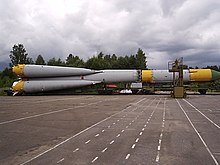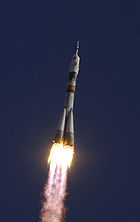Molniya (rocket)
 Molniya-M carrier rocket | |
| Function | Medium launch vehicle |
|---|---|
| Manufacturer | Energia |
| Country of origin | Soviet Union |
| Size | |
| Height | 43.44 m |
| Diameter | 10.3 m |
| Mass | 305,000 kg |
| Stages | 4 |
| Associated rockets | |
| Family | R-7 |
| Launch history | |
| Status | Retired |
| Launch sites | Baikonur, Plesetsk |
| Total launches | 40 |
| Success(es) | 20 |
| Failure(s) | 9 |
| Partial failure(s) | 11 |
The Molniya (Russian: Молния, meaning "lightning"), GRAU Index 8K78, was a modification of the well-known R-7 Semyorka rocket and had four stages.[1][2] The rocket was given the name Molniya due to the large number of Molniya communication satellites the rockets launched.[3]
History
[edit]The 8K78 resulted from a crash program by the Korolev Bureau to develop a booster for launching planetary probes. A larger third stage was added along with a fourth stage (Blok L) that was designed to fire in-orbit to send the payload out of LEO (replacing the inaccurate direct ascent of the first generation Luna probes launched on the 8K72) and the core and strap-ons had the new uprated 8D74K first stage engines. The first couple of 8K78s flown used an 8K74 core however vehicles flown in 1962-63 used the older 8K71 core. The 8K74 core returned for vehicles flown in 1964 and later.
The initial 8K78s had a faulty Blok I design that was prone to vibration issues and pump cavitation. The Blok I was redesigned afterward and the improved version was first flown on 11 November 1963. The uprated 8K78M booster was introduced in 1965 but 8K78s continued to fly into 1967.[4][5][6][7] The Molniya also carried early Venera probes to Venus.[2]
Molniya (E6) was a minor revision adapted for Luna E-6 series space probes where the guidance system for the entire launch vehicle was moved to the probe itself.[2]
Characteristics
[edit]- Length: 43.440 m
- Diameter: 10.300 m
- Launch mass: 305,000 kg
- Strap-On Boosters: Blok-B,V,G,D / 4 × RD-107[2]
- Stage 1: Blok-A / RD-108K[2]
- Stage 2: Blok-I / RD-0108[2]
- Stage 3: Blok-L / S1.5400[2]
Launches
[edit]Molniya rockets were launched 40 times:[2]
| Date | Version | Serial No. | LS | Payload | Result |
|---|---|---|---|---|---|
| 10.10.1960 | Molniya | L1-4M | Baikonur LC-1/5 | Mars (1a) (1M #1) | Failure |
| 14.10.1960 | Molniya | L1-5M | Baikonur LC-1/5 | Mars (1b) (1M #2) | Failure |
| 04.02.1961 | Molniya | L1-7V | Baikonur LC-1/5 | Venera (1a) (1VA #1, Sputnik 7) | Partial failure |
| 12.02.1961 | Molniya | L1-6V | Baikonur LC-1/5 | Venera 1 (1VA #2, Sputnik 8) | Success |
| 25.08.1962 | Molniya | T103-12 | Baikonur LC-1/5 | Venera (2a) (2MV-1 #1, Sputnik 19) | Partial failure |
| 01.09.1962 | Molniya | T103-13 | Baikonur LC-1/5 | Venera (2b) (2MV-1 #2, Sputnik 20) | Partial failure |
| 12.09.1962 | Molniya | T103-14 | Baikonur LC-1/5 | Venera (2c) (2MV-2 #1, Sputnik 21) | Partial failure |
| 24.10.1962 | Molniya | T103-15 | Baikonur LC-1/5 | Mars (1c) (2MV-4 #1, Sputnik 22) | Partial failure |
| 01.11.1962 | Molniya | T103-16 | Baikonur LC-1/5 | Mars 1 (2MV-4 #2, Sputnik 23) | Success |
| 04.11.1962 | Molniya | T103-17 | Baikonur LC-1/5 | Mars (2a) (2MV-3 #1, Sputnik 24) | Partial failure |
| 04.01.1963 | Molniya (E6) | T103-09 | Baikonur LC-1/5 | Luna E-6 No.2 Luna (4c) (Ye-6 No.2, Sputnik 25) | Partial failure |
| 03.02.1963 | Molniya (E6) | G103-10 | Baikonur LC-1/5 | Luna E-6 No.3 Luna (4d) (Ye-6 No.3) | Failure |
| 02.04.1963 | Molniya (E6) | G103-11 | Baikonur LC-1/5 | Luna 4 (Ye-6 No.4) | Success |
| 11.11.1963 | Molniya | G15000-017 | Baikonur LC-1/5 | Kosmos 21 (Zond (1a)) (3MV-1A #1) | Partial failure |
| 19.02.1964 | Molniya (M) | T15000-019 | Baikonur LC-1/5 | Zond (1b) (3MV-1A #2) | Failure |
| 21.03.1964 | Molniya (E6) | T15000-020 | Baikonur LC-1/5 | Luna (5a) (Ye-6 No.6) | Failure |
| 27.03.1964 | Molniya (M) | T15000-022 | Baikonur LC-1/5 | Kosmos 27 (Zond (1c)) (3MV-1 #1) | Partial failure |
| 02.04.1964 | Molniya (M) | G15000-028 ? | Baikonur LC-1/5 | Zond 1 (3MV-1 #2) | Success |
| 20.04.1964 | Molniya (E6) | T15000-021 | Baikonur LC-1/5 | Luna (5b) (Ye-6 No.5) | Failure |
| 04.06.1964 | Molniya | G15000-018 | Baikonur LC-1/5 | Molniya-1 (1a) (Molniya-1 2L) | Failure |
| 22.08.1964 | Molniya | G15000-019 | Baikonur LC-1/5 | Kosmos 41 (Molniya-1 (1b)) (Molniya-1 1L) | Success |
| 30.11.1964 | Molniya | G15000-029 | Baikonur LC-1/5 | Zond 2 (3MV-4 #1) | Success |
| 12.03.1965 | Molniya (E6) | G15000-024 | Baikonur LC-1/5 | Kosmos 60 (Luna (5c)) (Ye-6 No.9) | Partial failure |
| 10.04.1965 | Molniya (E6) | U15000-022 | Baikonur LC-1/5 | Luna (5d) (Ye-6 No.8) | Failure |
| 23.04.1965 | Molniya | U15000-035 | Baikonur LC-1/5 | Molniya-1 1 (Molniya-1 3L) | Success |
| 09.05.1965 | Molniya (M) | U15000-024 | Baikonur LC-1/5 | Luna 5 (Ye-6 No.10) | Success |
| 08.06.1965 | Molniya (M) | U15000-033 | Baikonur LC-1/5 | Luna 6 (Ye-6 No.7) | Success |
| 18.07.1965 | Molniya | U15000-032 | Baikonur LC-1/5 | Zond 3 (3MV-4 #2) | Success |
| 14.10.1965 | Molniya | U15000-034 | Baikonur LC-1/5 | Molniya-1 2 (Molniya-1 4L) | Success |
| 12.11.1965 | Molniya (M) | U15000-042 | Baikonur LC-31/6 | Venera 2 (3MV-4 #3) | Success |
| 16.11.1965 | Molniya (M) | U15000-031 | Baikonur LC-31/6 | Venera 3 (3MV-3 #1) | Success |
| 23.11.1965 | Molniya (M) | U15000-030 | Baikonur LC-31/6 | Kosmos 96 (Venera (4a)) (3MV-4 #4) | Partial failure |
| 03.12.1965 | Molniya | U15000-048 | Baikonur LC-31/6 | Luna 8 (Ye-6 No.12) | Success |
| 27.03.1966 | Molniya (M) | U15000-040 | Baikonur LC-31/6 | Molniya-1 (3) (Molniya-1 5L) | Failure |
| 25.04.1966 | Molniya (M) | N15000-037 | Baikonur LC-31/6 | Molniya-1 3 (Molniya-1 6L) | Success |
| 20.10.1966 | Molniya (M) | N15000-040 | Baikonur LC-1/5 | Molniya-1 4 (Molniya-1 7L) | Success |
| 24.05.1967 | Molniya (M) | N15000-041 | Baikonur LC-1/5 | Molniya-1 5 (Molniya-1 8L) | Success |
| 31.08.1967 | Molniya (M) | N15000-081 | Baikonur LC-1/5 | Kosmos 174 (Molniya-1Yu 11L) | Success |
| 03.10.1967 | Molniya (M) | Ya15000-083 | Baikonur LC-1/5 | Molniya-1 6 (Molniya-1 9L) | Success |
| 22.10.1967 | Molniya (M) | Ya15000-084 | Baikonur LC-1/5 | Molniya-1 7 (Molniya-1 12L) | Success |
See also
[edit]References
[edit]- ^ Harvey, Brian (5 July 2007). Russian Planetary Exploration: History, Development, Legacy and Prospects. Springer. p. 73. ISBN 978-0-387-46343-8.
- ^ a b c d e f g h i "Molniya (8K78)". Gunter's Space Page. Retrieved 23 October 2023.
- ^ Reichl, Eugen (2019). The Soviet Space Program - The Lunar Mission Years: 1959 to 1976. Schiffer Publishing Ltd. p. 32. ASIN 0764356755.
- ^ Encyclopedia Astronautica Molniya-1 Archived 16 May 2008 at the Wayback Machine
- ^ Encyclopedia Astronautica Molniya 8K78M Archived 8 May 2012 at the Wayback Machine
- ^ Encyclopedia Astronautica Molniya-2 Archived 2 June 2012 at the Wayback Machine
- ^ Lardier, Christian; Barensky, Stefan (2013). The Soyuz Launch Vehicle: The Two Lives of an Engineering Triumph. New York: Springer. p. 156. doi:10.1007/978-1-4614-5459-5. ISBN 978-1-4614-5458-8.
External links
[edit]- "Molniya-M Carrier Rocket". РКЦ Прогресс. Retrieved 7 October 2014.

